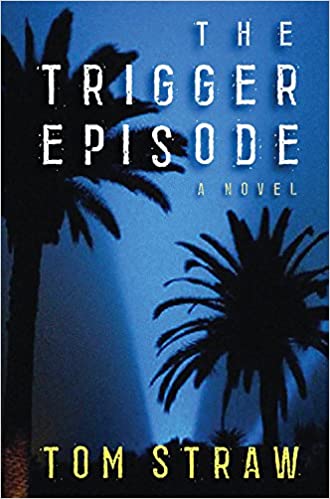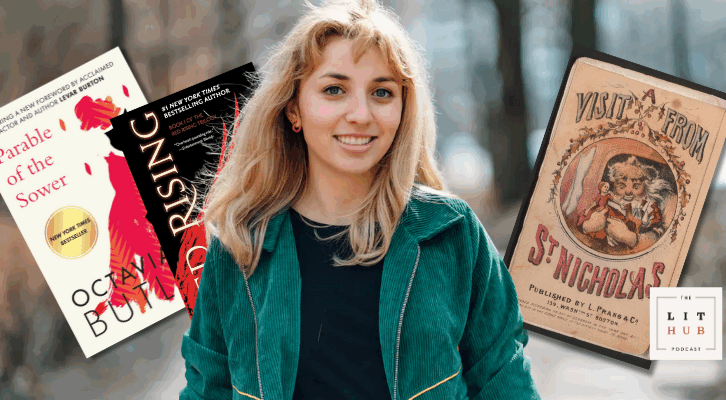The rule of thumb in book publishing is simple: Unless your name is Harper Lee, your first novel will not be your best and most likely won’t be a bestseller either. All other mere mortals in the world must rely on a well-measured publishing axiom known as the learning curve. Tom Straw is no exception to the rule for first-time authors, but the rest of his publishing career broke every rule in the book.
The first rule he broke was his identity. It was a closely held secret for seven years. This seven-time New York Times bestselling author (yes, he hit number one), was only outed in recent years and has earned the moniker as the best unknown author on the New York Times list. He wrote under the pseudonym of Richard Castle. That’s right, that Richard Castle of the television series “Castle” about a novelist who regains his mojo by riding along with a New York police detective as she solves her cases and he falls in love with her. During the show’s seven-year run, no one would reveal who really wrote Richard Castle’s “Nikki Heat” television tie-in novels, which led to one of the biggest guessing games in Burbank Writers Rooms and New York City crime genre circles.
Even though Nathan Fillion, the actor who starred as Richard Castle, would show up for book signings, he never claimed to have written the books and would sign them as himself, not as Richard Castle. Tom Straw wasn’t concerned about which signature was scribbled on the page as much as he was grateful that sometimes 500 people would show up at a book signing.
It pays to have an actor playing you.
Yet long before there was the TV show, there was Tom Straw, successful DJ and television writer who wrote for such shows as “Night Court,” “Cosby,” “Nurses,” “Grace Under Fire,” “Dave’s World,” “Nurse Jackie,” and so many more—many of them as showrunner—the boss who everyone answers to.
His television and radio work came long before his career as a novelist. So, his bestselling novelist history can’t be told without first talking about his writing beginnings.
Tom always loved to read books as a kid and as he grew up in Southern California, he decided he wanted to be a radio DJ and write the short bits between songs. His first gig was at a small station in the San Fernando Valley. As a teen, he would grab some albums from home and talk friends into driving him to work for the 6-9 p.m. weekday shift.
While still in high school, he met Ken Levine, who was a disc jockey at UCLA’s radio station KLA. “We became fast friends and have been so ever since.”
Around 1974, Tom was program director at KSEA, the FM top-40 station in San Diego. He had an opening for an evening DJ and hired Ken. “We finally got a chance to work together. That fun lasted only until December of that year when the owner suddenly fired us all—the whole staff—a week before Christmas, to change format to All-Christian. The irony of that timing wasn’t lost on us, abruptly unemployed and feeling kind of, well, Scrooged.”
Straw was a DJ for a decade, moving to Philly, St. Louis and Seattle. “Radio was fine, but honestly, a dead-end for a reflective person. Then, as now, I always felt like I needed to dig deeper, creatively. I recognized, without realizing it consciously, that I got into radio as a way to scratch my writing itch. When twelve seconds to accomplish that over the intro to ‘Honky Cat’ lacked a certain fulfillment, I made a new plan. The phrase ‘reinventing yourself’ didn’t exist back then, but that was absolutely what I knew I needed to do, else I devolve into that pathetic DJ character in Harry Chapin’s ‘W·O·L·D’.”
“I had long wanted to be a writer, and I suppose it was watching Ken Levine step from that catalytic sacking at KSEA to breaking into sitcom writing that suggested a path for me. It took me a few years to make the commitment, though. But after five years of getting bored spinning records concurrent with a one-year stint as TV weathercaster on the NBC station in St Louis, which also became tedious, I was ready. Ken and I were still in touch. By this time, he was in LA writing for “M*A*S*H,” and I was in Seattle programming talk radio. He gave me long-distance mentorship, including the incalculable favor of reading and giving editorial notes on spec scripts I would send him.”
Moving to LA was a strategic move for Tom. Fortunately, it came with a bit of financial security.
“I knew if I was serious about breaking into TV writing, I needed to live in the place they made most of the TV. The safety net was that the station I worked at in Seattle had a big sister, KMPC, the company’s Los Angeles flagship station. I wrangled a transfer and became its program director, a demanding, full-time job, but I still had my weekends to write spec sitcoms, plus I got a subsidized move to Hollywood. It worked out okay.”
His friend Ken worked in television and with his writing partner David Isaacs and became television producers. Not only did they work on “M*A*S*H,” but “Cheers,” “AfterM*A*S*H” and later “Frasier.” Ken and David invited Tom to pitch story ideas to Executive Producer Bert Metcalf.
“Ken could get me in the door, but he couldn’t get me a job.”
Tom arrived armed with 30 story ideas after lunch and finished pitching 10 before Metcalf fell asleep at the table. But Metcalf sparked to one pitch and hired Tom to write an episode of “AfterM*A*S*H.” From there Tom was asked to write scripts for “Silver Spoons” and “Benson.” The producer for “Benson” offered him a staff job. He asked Ken’s advice and Ken recommended not to take it because he wanted Tom on staff for a follow up to the “Mary Tyler Moore” show called “Mary.” It lasted 13 episodes.
That led to two years on the TV sitcom “Night Court,” one of his most pleasant writing experiences. Executive Producer Reinhold Weege offered him the gig, which Tom accepted, and he became producer in just his second year.
He still keeps in touch with some of the show’s staff. Star John Larroquette once gave him a throw pillow for Christmas embroidered with, “Dying is easy. Comedy is hard.”
He worked on several TV series. His typical day was to arrive at the office by ten for a writers meeting and spend the rest of the day fixing the current manuscript for that week’s shoot, editing last week’s shoot and working on next week’s show and other future manuscripts. The day didn’t usually start until ten because the writers often stayed late into the night rewriting manuscripts for the next day’s shoot. It was an intense grind from July through March. And by the end of each television season, he admits, the writers were spent. Typically, he says, he took a month-long vacation to recharge and then work on freelance projects before the cycle started all over again the following July.
Eventually, he decided to take a break from the production grind. In 1998 he decided to move to the East Coast to be close to New York and closer to family. “I’d saved enough money to get off of the treadmill. I wanted to write screenplays and books.”
“I’m a serious person when it comes to craft and writing anyway, I really bore down. I was writing out of my home office and treated it like a job.” One of his many projects included a screenplay he co-wrote with actor Gene Wilder.
He’d written a screenplay three years earlier that was optioned by a major film producer but never got made. But he fell in love with the main character and his relationships with other characters in the story.
“I was so into that character and so much believed that character would drive a story. So, I took him and put him into a different story in a different medium: a mystery novel. It marked the beginning of what would become The Trigger Episode.” When Tom was finished, he promptly chopped a third of the manuscript. “It was part of the learning curve.”
Something every novelist should learn.
Tom Werner, executive producer of “Cosby,” a CBS sequel to the famed NBC “The Cosby Show,” asked Tom what he was thinking by leaving Los Angeles for New York. “Hey, would you ever run ‘Cosby’?” Werner asked.
“I was kind of burnt out on TV, but, to borrow a phrase from my friend Clyde Phillips, he held a gun to my wallet,” Tom says. He flew back to L.A. and met with CBS, then back to New York to meet with Bill Cosby and became the showrunner for two seasons.
He was still eager to get back to his novel when another New York-based show came calling. The new TV show “Whoopi,” starring Whoopi Goldberg, needed his help. “Just when I thought I was out, they pulled me back in.”
So even after moving to New York to write his first novel, it was still years later before he actually got the chance to finish it. “I resumed it with fervor after that. I was determined to get it published.”
Tom already had a television agent at ICM Partners, so it was an easy ask to get the firm to find him an agent for his novel. “I didn’t do the grand tour of agents. I was fairly well established as a TV entity.” In fact, he’d already gone through that ordeal earlier in his career when he was starting in television.
Will Balliett, who was with Carroll & Graf, an independent publishing house, bought his thriller, The Trigger Episode, a novel about a photojournalist in search of a missing TV star. When it was published, it got good reviews. All seemed like he was ready to explode out of the box, and then fate stepped in. His publisher was bought out by a German firm. And his new publisher was not interested in publishing fiction. So, The Trigger Episode, despite good notices, got little promotional push.
Welcome, Tom Straw, to the crazy roller coaster of book publishing, where you’re up one minute and down the next.
Fast forward to 2009. Tom was having lunch with Balliett, who had moved to Hyperion Books, then a division of Disney. At the end of lunch, Balliett mentioned the TV series “Castle,” broadcast on Disney’s ABC network. He explained the premise about a famous novelist, Richard Castle, who had lost his muse, so he goes to observe and help New York City Police Detective Kate Beckett and her team. Balliett asked Tom if would be willing to ghostwrite a series tie-in novel as if he were the TV character Castle.
At the time, Tom was commuting monthly to Hollywood where he was working as a writer and comedy segment director on the CBS “Late Late Show with Craig Ferguson.” On his west coast trip the following week, he met with “Castle” Executive Producer Andrew W. Marlowe, who had created the TV series. Everything jelled since both men were showrunners and spoke the same language.
“Next thing I know, I’m writing Heat Wave as Richard Castle…Our agreement was the books would be Richard Castle, the TV character’s idealized version of himself and his experiences on his ride-along in the show.”
For seven years he went on to no fame, but lots of fortune, with each novel becoming a New York Times best seller. With the series’ ending and with Tom finally receiving credit for his work, writing offers flowed.
“I primarily work on books now, but I get calls often from television.” He’s become known in TV circles as a fixer of “troubled” shows. “I became the Red Adair (the famed oil field fire fighter) of sitcom. I was the guy they brought in to help get good shows back on track.”
While his phone is still ringing, most often now he says no, determined to write screenplays and novels.
“I’m fortunate to be able to still be working and more than that, it’s meaningful work.” He’s recently optioned a yet-to-be published spy novel for television and is busy writing its pilot episode.
He went from taking three years to write his first novel, The Trigger Episode, to three months to write his first Nikki Heat novel, Heat Wave.
“That’s what you call a learning curve,” he says.

___________________________________
The Trigger Episode
___________________________________
Decided to write a novel: 51
Time to Write Novel: 3 years
Experience: Television writer
Agents Contacted: One
Agent Rejections: None
Agent Submissions: One
Time to Sell Novel: Weeks
First Novel Agent: Sloan Harris, ICM Partners
First Novel Editor: Will Balliett
First Novel Publisher: Carroll & Graf
Age when first published: 54
Inspiration: A lifetime of voracious reading
Website: TomStraw.com
Advice to Writers: Read like crazy. Treat it like a job. Have a thick skin. Be very honest with yourself about what you’ve written. Don’t sweep things under the rug.
___________________________________
Like this? Read the chapters on Lee Child, Michael Connelly, Tess Gerritsen, Steve Berry, David Morrell, Gayle Lynds, Scott Turow, Lawrence Block, Randy Wayne White, and Walter Mosley.
—From “My First Time,” an anthology in progress by Rick Pullen. rickpullen.com


















